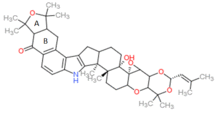
Lolitrem B

Lolitrem B is one of many toxins produced by a fungus called Epichloë festucae (var. lolii), which grows in perennial ryegrass. The fungus is symbiotic with the ryegrass; it doesn't harm the plant, and the toxins it produces kill insects that feed on ryegrass. Lolitrem B is one of these toxins, but it is also harmful to mammals. The shoots and flowers of infected ryegrass have especially high concentrations of lolitrem B, and when livestock eat too much of them, they get perennial ryegrass staggers. At low doses the animals have tremors, and at higher doses they stagger, and at higher yet doses the animals become paralyzed and die. The blood pressure of the animals also goes up. The effect of the lolitrem B comes on slowly and fades out slowly, as it is stored in fat after the ryegrass is eaten. The condition is especially common in New Zealand and Australia, and plant breeders there have been trying to develop strains of fungus that produce toxins only harmful to pests, and not to mammals. Lolitrem B is one of many toxins produced by a fungus called Epichloë festucae (var. lolii), which grows in perennial ryegrass. The fungus is symbiotic with the ryegrass; it doesn't harm the plant, and the toxins it produces kill insects that feed on ryegrass. Lolitrem B is one of these toxins, but it is also harmful to mammals. The shoots and flowers of infected ryegrass have especially high concentrations of lolitrem B, and when livestock eat too much of them, they get perennial ryegrass staggers. At low doses the animals have tremors, and at higher doses they stagger, and at higher yet doses the animals become paralyzed and die. The blood pressure of the animals also goes up. The effect of the lolitrem B comes on slowly and fades out slowly, as it is stored in fat after the ryegrass is eaten. The condition is especially common in New Zealand and Australia, and plant breeders there have been trying to develop strains of fungus that produce toxins only harmful to pests, and not to mammals. Lolitrem B affects a kind of ion channel called BK channels. These channels normally open temporarily to allow neurons and other electrically-sensitive cells, like some heart cells, to 'reset' after they fire; lolitrem B blocks them, preventing the neuron or heart cell from firing again. This affects nerve and heart function. The channel is also involved in blood vessel relaxation, and blocking the channel causes blood vessels to constrict, raising blood pressure. The Lolitrem B toxin derives the first part of its name ('Loli') from the source of the fungus (perennial ryegrass, also known as Lolium perenne), the middel part ('trem') due to the tremors the toxin is known to cause, and the last part of its name ('B') as part of a way to distinguish between different Lolitrems, based on their difference in chemical structure (see 'Chemistry'). Lolitrem B is found in perennial ryegrass that has been infected with the fungus Epichloë festucae (var. lolii). This fungus is an endophyte; for part of its lifecycle it lives inside plants, growing between the plant cells; it is most prevalent in the ryegrass stem. The fungus produces lolitrem B, one of several mycotoxins that kill pests but which also can be neurotoxins for mammals. When animals eat ryegrass stems infected with Epichloë festucae (var. lolii) they get a condition called perennial ryegrass staggers; in cases of mild poisoning the animals get tremors, and in severe poisoning they stagger and collapse. In horses, tremors of the eyeball muscles are seen which are more severe during eating and exercise. Lolitrem B can also increase the heart rate, blood pressure, respiration rate and disrupt the digestion process. Lolitrems distinguish themselves among tremorgenic neurotoxins because they induce a long lasting effect on motor function and heart rate. The tremors can last for hours and at high concentrations they can cause death. In animals, lolitrem B more often causes death related to unfortunate accidents such as falling in a pond. The neurotoxic effects can be completely reversed. The threshold for toxicity varies between species of animals: for sheep a threshold value of 1.8 - 2.0 mg/kg was found, and for cattle 1.55 mg/kg. Measuring the lolitrem B concentration in fat tissue can be used to estimate the amount of lolitrem B consumed, and is used to determine the cause of death for cattle that presenting with neurological symptoms. Lolitrem B likely acts synergistically with ergotamine to increase smooth muscle contraction. Epichloë festucae (var. lolii) infects ryegrass worldwide, but cases of perennial ryegrass staggers are rare outside of Australia and New Zealand; the reasons for this are unclear but may have to do with the purposeful selection of endophyte-infected ryegrass by plant breeders, who prize its resistance to pests which are more prevalent in Australia and New Zealand than elsewhere, and the practice of monoculture by farmers in those countries. Plant breeders have been working with mycologists in Australia and New Zealand to develop strains of fungus that produce mycotoxins that are toxic to pests but not to mammals. Until those become commercially established the best prevention is avoiding grazing livestock on ryegrass when the stems are emerging and while the plant is flowering (concentrations are highest in the mature inflorescence and in the base of the plant), and avoiding overgrazing; once the exposure to lolitrem B ends the symptoms gradually decrease. Lolitrem B is rapidly eliminated from serum and has a half-life of 14 minutes. Lolitrem B is not very soluble, and is generally stored in fat after ingestion and slowly released; this is likely why its effects come on slowly and linger after ingestion has stopped. The more that is ingested, the more is stored in fat.
